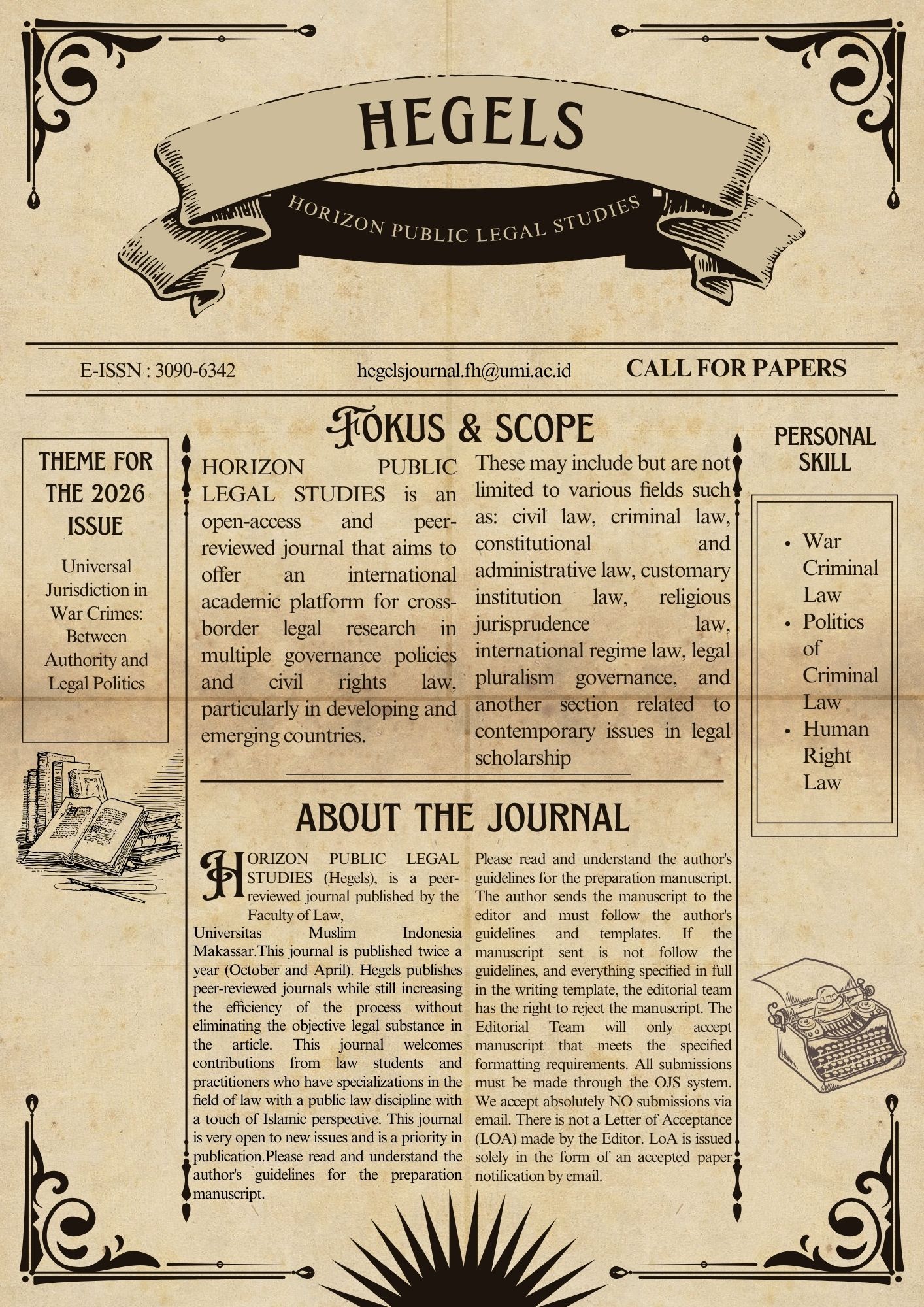COLD-BLOODED CYBER EXTORTION TRAP: The Method of Distributing Immoral Content as a Criminal Weapon of Threats on Social Media
DOI:
https://doi.org/10.56087/hegels.v2i1.1324Keywords:
Investigation, Crime, Blackmai, Social MediaAbstract
This study aims to determine and analyze the investigation process for criminal acts of threats and extortion via social media and to identify the inhibiting factors in the investigation of criminal acts of threats and extortion via social media, particularly involving the distribution of immoral content. This study employed empirical research methods. Data collection techniques included interviews and documentation. The study was conducted in Makassar, specifically at the South Sulawesi Regional Police Headquarters. The results of the author's research are that the process of investigating criminal acts of threats with extortion is the same as handling other general crimes if the report is received then an investigation warrant and SP2HPA1 (Notification of the progress of the report research results) are issued. The results of the investigation find at least 2 initial pieces of evidence that are sufficient in accordance with the provisions of Article 184 of the Criminal Procedure Code then the status will be raised from the preliminary stage to the preliminary stage and the issuance of SP2HP A3 (Notification of Investigation Results) is issued. However, if the results of the investigation of the reported case are not a criminal case or do not meet the provisions of Article 184 of the Criminal Procedure Code then the investigation must be stopped and the issuance of SP2HP A2 (Notification of the Progress of Investigation Results) or usually the investigation is stopped. The inhibiting factors in the investigation process against suspects who commit criminal acts of threats and extortion through social media include sometimes the reported party is not cooperative, evidence has been deleted which results in the digital tracking process becoming more complicated and long, and the perpetrator is usually outside the jurisdiction of the South Sulawesi Regional Police and there is often a lack of witnesses and evidence. The author's recommendation is that the police should increase cooperation in resolving criminal cases, both with related agencies and with the public. There is also the need for comprehensive public education regarding the importance of a cooperative attitude when dealing with the law to facilitate investigations and handling of a case. The public also needs to increase awareness of electronic media security and participate in reporting cybercrime to the police. Law enforcement officers also need to be equipped with adequate tools and strengthen coordination and cooperation between the government, law enforcement officers, and the public. Thus, these steps are expected to increase the effectiveness of law enforcement and reduce obstacles in overcoming the spread of immoral content through electronic media.
References
[1] M. R. H. Liviani, “Kejahatan Teknologi Informasi ( Cyber Crime ) dan Penanggulangannya dalam Sistem Hukum Indonesia,” UIN Sunan Ampel, vol. 23, no. 2, 2020.
[2] M. I. Asrum, H. Thalib, and M. Jannah, “Criminological Review of the Phenomenon of Cyberbullying,” Horiz. Public Leg. Stud., vol. 1, no. 1, pp. 32–49, 2024, doi: 10.56087/hegels.v1i1.490.
[3] S. R. Ummah, “Pornografi Ditinjau dari Hukum Positif dan Hukum Pidana Islam,” Al-Qanun J. Pemikir. dan Pembaharuan Huk. Islam, vol. 20, no. 1, pp. 26–35, 2018, doi: 10.15642/alqanun.2017.20.1.26-35.
[4] A. Aswari, “Perlindungan Hukum Tanpa Penegakan Hukum Dalam Sengketa Transaksi Elektronik,” Kertha Patrika, vol. 42, no. 2, p. 163, 2020, doi: 10.24843/kp.2020.v42.i02.p05.
[5] T. S. Ramli et al., “Prinsip Prinsip Cyber Law Pada Media Over the Top E-Commerce Berdasarkan Transformasi Digital Di Indonesia,” J. Legis. Indones., vol. 16, no. 3, pp. 392–398, 2019.
[6] Y. H. Lokapala, F. J. Nurfauzi, and Y. Widowaty, “Aspek Yuridis Kejahatan Phishing dalam Ketentuan Hukum di Indonesia,” Indones. J. Crim. Law Criminol., vol. 5, no. 1, pp. 19–24, 2024, doi: 10.18196/ijclc.v5i1.19853.
[7] T. Handayani, “Perlindungan Dan Penegakan Hukum Terhadap Kasus Kekerasan Seksual Pada Anak,” J. Huk. Mimb. Justitia, vol. 2, no. 2, p. 826, 2018, doi: 10.35194/jhmj.v2i2.33.
[8] S. Yuniarti, “Perlindungan Hukum Data Pribadi Di Indonesia,” Bus. Econ. Commun. Soc. Sci. J., vol. 1, no. 1, pp. 147–154, 2019, doi: 10.21512/becossjournal.v1i1.6030.
[9] E. Priliasari, “PERLINDUNGAN DATA PRIBADI KONSUMEN DALAM TRANSAKSI E-COMMERCE MENURUT PERATURAN PERUNDANG-UNDANGAN DI INDONESIA (Legal Protection of Consumer Personal Data in E-Commerce According To Laws dan Regulations in Indonesia),” J. Rechts Vinding, vol. 12, no. 2, pp. 261–279, 2023.
[10] N. Qamar et al., “Metode Penelitian Hukum (Legal Research Methods),” no. December, p. 176, 2017.
[11] Muhammad FauziRamadhan, M. Jannah, and A. Putera, “TERTIPU LINK , TERKURAS PRIVASI , DI MANA KEADILAN HUKUM ?,” JUDICATUM J. Dimens. Catra Huk., vol. 3, no. 1, pp. 236–251, 2025, doi: https://doi.org/10.35326/judicatum.v3i1.7725.
[12] M. F. Ramadhan, “Legal Review of Action Criminal Exploitation of Street Children at Crossroads in the Name of Beggars,” vol. 1, no. 2, pp. 1–7, 2025.
[13] M. Fauzi Ramadhan, “Pengantar Ilmu Hukum.” 2016.
[14] P. K. Nurdianto, “Jurnal Cakrawala Informasi,” Cakrawala Inf., vol. 1, no. 1, pp. 1–14, 2021.
[15] Sulastryani, “Peran Penyidik Dalam Penanganan Tindak Pidana Pencemaran Nama Baik Melalui Media Sosial (Studi Kasus Polres Palopo),” J. to ciung. J. Ilmu Huk., vol. 1, pp. 50–63, 2021.
[16] Munadi, “Diskursus Hukum,” Sustain., vol. 11, no. 1, pp. 1–14, 2019, [Online]. Available: http://scioteca.caf.com/bitstream/handle/123456789/1091/RED2017-Eng-8ene.pdf?sequence=12&isAllowed=y%0Ahttp://dx.doi.org/10.1016/j.regsciurbeco.2008.06.005%0Ahttps://www.researchgate.net/publication/305320484_SISTEM_PEMBETUNGAN_TERPUSAT_STRATEGI_MELESTARI
Downloads
Published
Issue
Section
License
Copyright (c) 2025 Surya Wirawan, Nur Fadhilah Mappaselleng, Dwi Handayani

This work is licensed under a Creative Commons Attribution-ShareAlike 4.0 International License.


